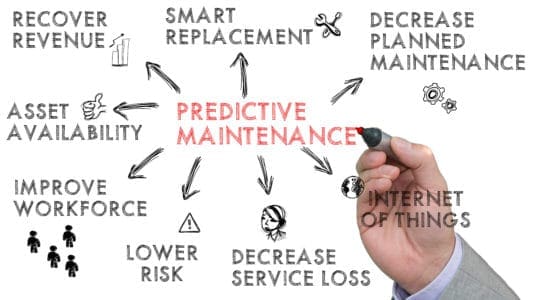5 Ways Industry 4.0 Technologies Can Improve Supply Chain Planning
| By Adam Sgammotta | 0 Comments

The COVID-19 pandemic introduced many challenges to the manufacturing industry. First, there was an unprecedented rise in consumer demand. Then, there were disruptions in many areas of the supply chain, including procurement, transportation/logistics, warehousing, and order fulfillment. Although the pandemic has mostly come to an end, these challenges are still present today.
Manufacturers have found ways to overcome these challenges, largely by prioritizing supply chain planning and integrating Industry 4.0 technologies into their processes. Industry 4.0 is constantly evolving—while some manufacturers may be hesitant to implement these technologies, others have begun to see their value.
In this article, we’ll explore the five major ways Industry 4.0 has improved the overall supply chain planning process.
1. Real-Time Tracking & Data Transparency

First, supply chain planning managers today are using the connectivity of the Internet of Things (IoT) to leverage real-time tracking.
Real-time tracking is the ability to accurately follow the location of an item as it moves through the supply chain process. As the product is moved from location to location, an IoT-enabled tracker sends data to a server, which can be checked as frequently as needed. The tracking can also be timed against predetermined goals of days, hours, or minutes. This data transparency helps consumers stay informed of transportation issues and potential delays.
This is important because operational integrity has become more scrutinized by the consumer over the last decade. With real-time tracking, there aren’t any gray areas where the business can shift liability to other parts of the system while the item is waiting to be moved in the process. And, the customer can no longer blame the company for not meeting expectations because the customer was given an accurate expectation of when the item would be delivered.
The overall benefits of implementing real-time tracking include:
- Increased Efficiency
- Continuous Data Protection
- Improved Process Performance
- Reduction of Product Loss
- Improved Customer Satisfaction
- Increased Data Transparency
2. RFID & Warehousing

RFID (radio frequency identification) is quickly becoming the tool of choice when trying to improve the organization and management of inventory. The RFID technology which relies on radio-frequency to transfer data is being used in tags or chips that can be placed on items as they arrive in shipment. As the items move through the different processes, the tag’s internal memory is updated and can be uploaded for use in the warehouse management system via electromagnetic signals. Once the data is uploaded, it can then be analyzed to better help understand the flow of products, keeping inventory levels stocked and tracking what goes in and out of the building. With many companies focused on running lean, tracking these elements can be crucial to being profitable.
The RFID tags have a number of features that make them ideal for solving inventory tracking challenges over other traditional tools such as barcoding:
- No line of sight needed – RFID tags can be read from a distance and avoids each tag having to be scanned manually like older barcode technologies. The tags can even be read when behind other products which makes it possible to gather data from entire pallets of items at one time.
- Accuracy – The data from the tags are uploaded automatically eliminating the possibility of human error.
- Increased Amounts of Data – Barcodes are basically identifiers, but RFID tags can hold large amounts and a wide variety of information in the internal memory until it is uploaded.
- Efficiency – Tracking products in real-time can allow for re-configuring inventory to allow for the most optimum flow of items through the warehouse.
3. Data Sharing & Collaboration

In addition to increasing data transparency, Industry 4.0 technologies are also improving data sharing and collaboration.
As businesses are forced to become more competitive, they rely more and more on information technologies, such as IoT, artificial intelligence, and cloud services to increase connectivity with supply chain partners. For example, when manufacturing issues arise, data can be autonomously updated into a system which can then be shared with stakeholders, shipping companies, and even consumers.
Although this increase in communication has many benefits, including improved operational and strategic decision making, increased productivity, improved utilization of resources, and better flexibility and adaptability, possibly one of the most important improvements comes down to customer service.
If there are questions from customers, support staff can easily look at real-time data to help resolve the problems quickly in ways that were not possible a decade ago. By automatically keeping the customer informed of delays and managing expectations, manufacturers can reduce the amount of resources needed to improve the overall customer experience.
4. Reducing Equipment Downtime
Transportation and logistics issues aren’t the only cause of supply chain issues—equipment downtime during the manufacturing process can also create disruptions. That’s why more and more manufacturers are implementing predictive maintenance strategies into their supply chain planning processes.
Although predictive maintenance isn’t a brand-new technology, it has certainly evolved since its inception in the 1990s. Predictive maintenance refers to the practice of using data analysis tools and software to better determine when equipment or parts might fail. The goal is to replace or repair components prior to the predicted failure, rather than reacting to the failure afterwards. This maximizes the lifecycle of the machines without prematurely replacing components. It also prevents unnecessary downtime due to catastrophic failures.
And, by installing condition-monitoring sensors on equipment, managers are able to monitor the health of the equipment in real-time, as well as continuously adjust predictive maintenance plans to improve failure predictions.
5. Increasing Process Efficiency & Accuracy
Lastly, supply chain automation relies on intelligent, digital technologies to increase process efficiency and accuracy. As consumer demand increases for manufacturers, so does the implementation of automation tools like robots, artificial intelligence, and machine learning, which help increase the accuracy and speed of repetitive tasks.
Industrial robots and cobots can work continuously to accurately handle repetitive assembly and material handling applications. Allocating repetitive tasks to robots allows manufacturers to reassign skilled human workers to more valuable tasks. The accuracy of the robots also reduces rework or mistakes during these processes.
Additionally, AI and machine learning can process enormous amounts of data instantly, giving manufacturers a huge advantage when it comes to compiling data, organizing information, reporting trends, and controlling in-house or outside processes. Low-code automation platforms allow for complete process visibility where real-time information is loaded to a central database and machine learning is used to automatically improve the performance of tasks based on experience.
Improve Supply Chain Planning WIth Help From DSI
While Industry 4.0 technologies offer value to manufacturers, many are hesitant to implement because these technologies can be difficult to understand and challenging to integrate them into the workplace.
However, manufacturers who aren’t taking advantage of Industry 4.0 will lose out to their competitors who are. The future of manufacturing is in the digital enterprise, and it’s how manufacturers will stay relevant and competitive in the increasingly complex and demanding global market of tomorrow.
If you have questions about Industry 4.0 or need better supply chain planning solutions, turn to DSI. We’re a world-class engineering and consulting firm in North America. Some of our specialties include layout optimization, material flow, network design and optimization, integrated logistics operations design, and warehousing/distribution. No matter what industry you’re in, our team can help you find solutions to your supply chain challenges.
Fill out our online form today to schedule a free consultation with one of our experts.





